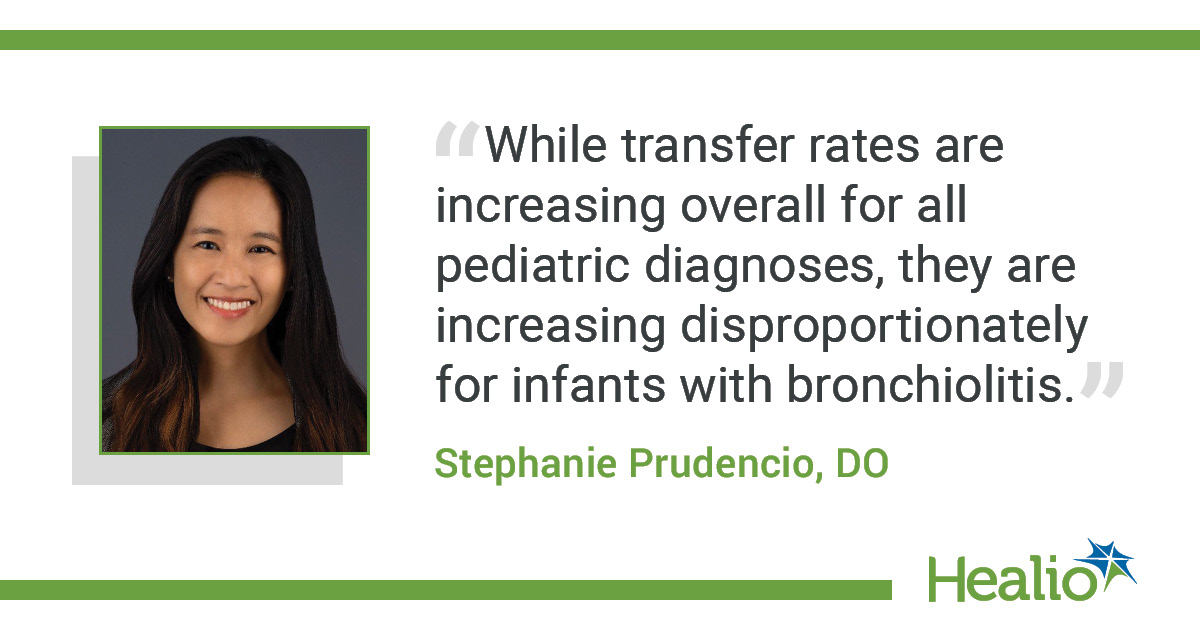Key takeaways:
- Compared with all pediatric hospitalizations, transfer rates for bronchiolitis were higher.
- Infants on public insurance were more likely to be transferred.
TORONTO — Pediatric hospital transfers due to bronchiolitis increased at a disproportionate rate in recent years compared with all causes of hospitalization, according to a study presented at the Pediatric Academic Societies Meeting.
The study served as a primary fellowship project for one of the researchers, who told Healio she was interested in “hospital operations and process improvement.”
“This is relevant to my daily practice as a pediatric medicine hospitalist, since patients transferred from outside facilities can contribute to the capacity of large referral centers and influence not just general inpatient units but also ICUs and surgical care,” Stephanie Prudencio, DO, a hospital medicine fellow at Children’s Hospital Los Angeles, told Healio at the meeting.
“I was interested in learning more about the transfer trends of a diagnosis such as acute bronchiolitis, which is a common diagnosis in general pediatrics that infrequently requires specialized care,” Prudencio said.
Prudencio and colleagues studied data from the Kids’ Inpatient Database, a publicly available dataset of U.S. inpatient hospitalizations, to generate national estimates of pediatric hospitalization patterns during the latest published years of 2012, 2016 and 2019, with a focus on children aged 0 to 12 months with acute bronchiolitis — “a common high-volume diagnosis that most general inpatient units should have the resources to manage,” Prudencio said.
The researchers found that compared with all pediatric hospitalizations, transfer rates for bronchiolitis were higher and increased disproportionately over time compared with all pediatric hospitalizations (2012, 10.2% vs. 5%; 2016, 13% vs. 5.6%; and 2019, 17.8% vs. 7.6%).
The increase in odds of bronchiolitis transfer as time progressed was significant (2012 vs. 2019, OR = 1.91; 95% CI, 1.55-2.35).
From 2012 to 2019, the researchers also noticed larger odds of transfer to urban nonteaching hospitals (OR = 2.99; 95% CI, 1.59-5.63), followed by rural (OR = 2.65, 95% CI, 1.41-4.98) and urban teaching hospitals (OR = 1.49; 95% CI; 1.19-1.87), as well as among patients with illness severity that was minor (OR = 1.81; 95% CI, 1.48-2.2) and moderate (OR = 1.78; 95% CI, 1.34-2.36).
“As expected, we saw increasing rates of transfer for infants with bronchiolitis, especially into urban hospitals, resulting from regionalization of pediatric care,” Prudencio said. “We were surprised to find that despite being less sick, we saw nearly double the odds of transfer in 2019 compared to 2012 for infants with minor illness.”
Additionally, the researchers found that infants who had public vs. private insurance had higher odds of transfer, and Black infants and Hispanic infants had lower odds of transfer compared with white infants.
The data reveal potential areas of improvement in interfacility transfer processes, Prudencio said, adding that it is unclear if “transferring for this often-uncomplicated diagnosis is beneficial for patients and their caregivers.”
She is interested in future studies evaluating patient-level risk factors to help guide transfer processes and potentially avoidable transfers for a common pediatric diagnosis such as acute bronchiolitis.
“While transfer rates are increasing overall for all pediatric diagnoses, they are increasing disproportionately for infants with bronchiolitis,” Prudencio said. “EDs and hospitals can implement operational efforts to strengthen community resources and education for the care of infants with bronchiolitis to minimize racial, payor and geographic disparities.”
